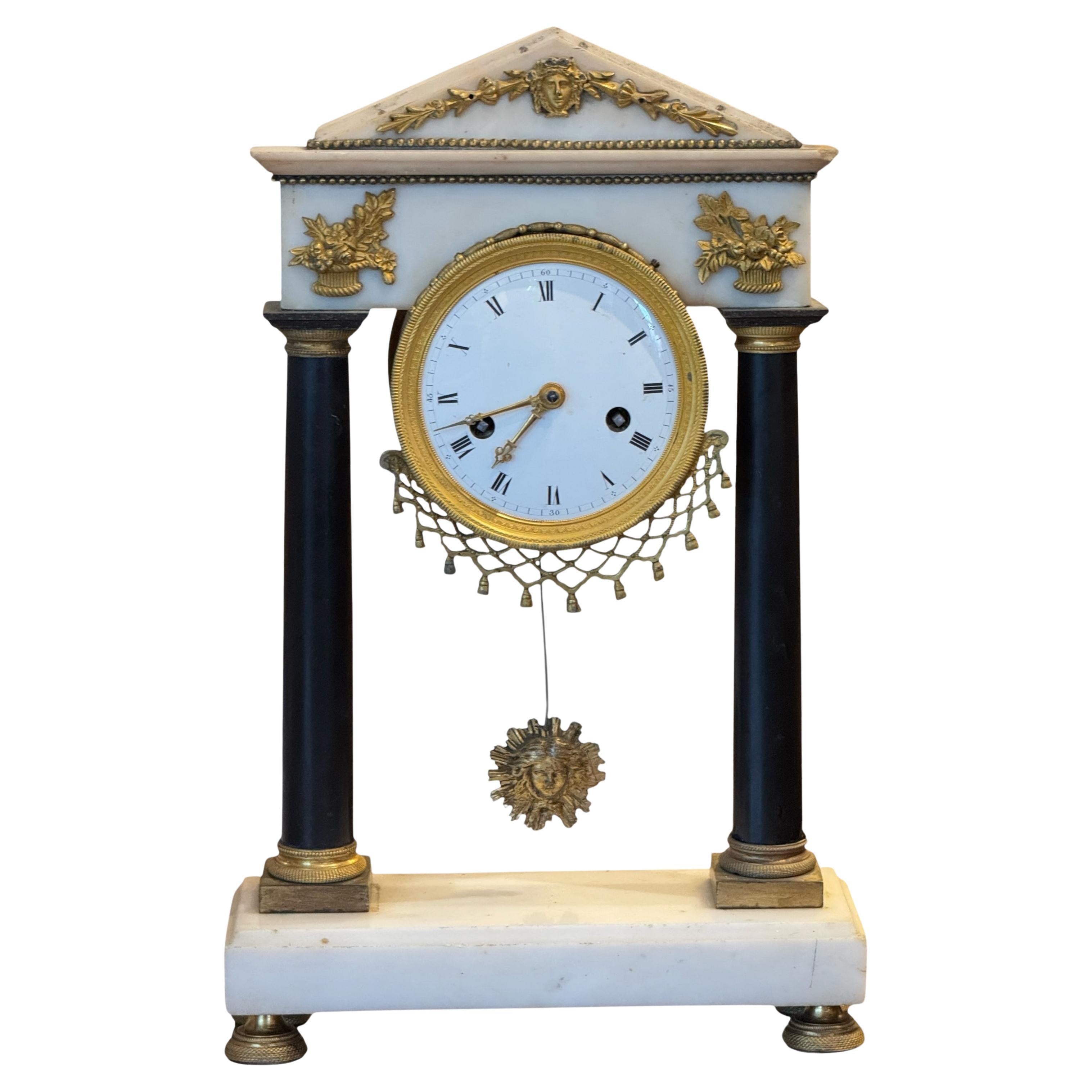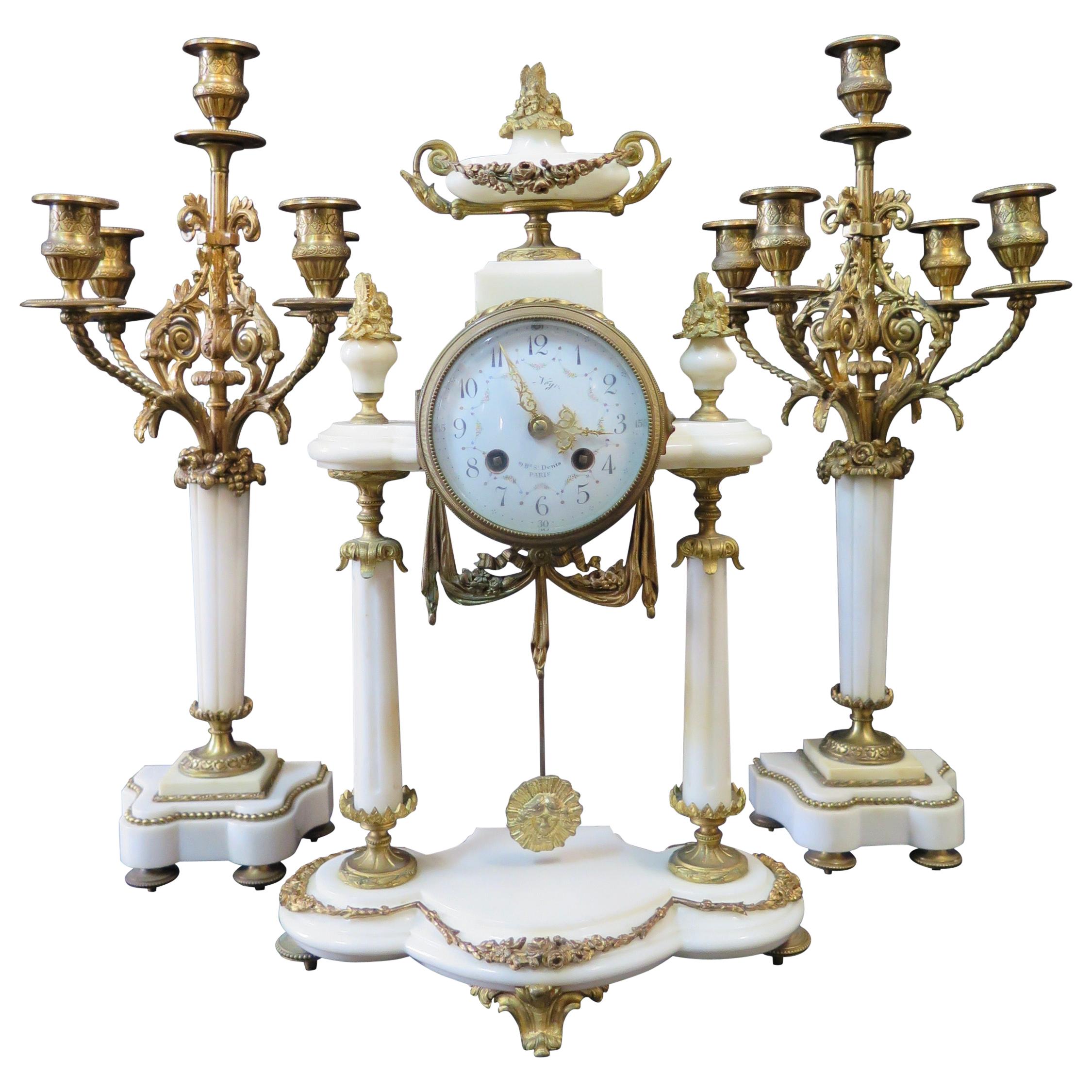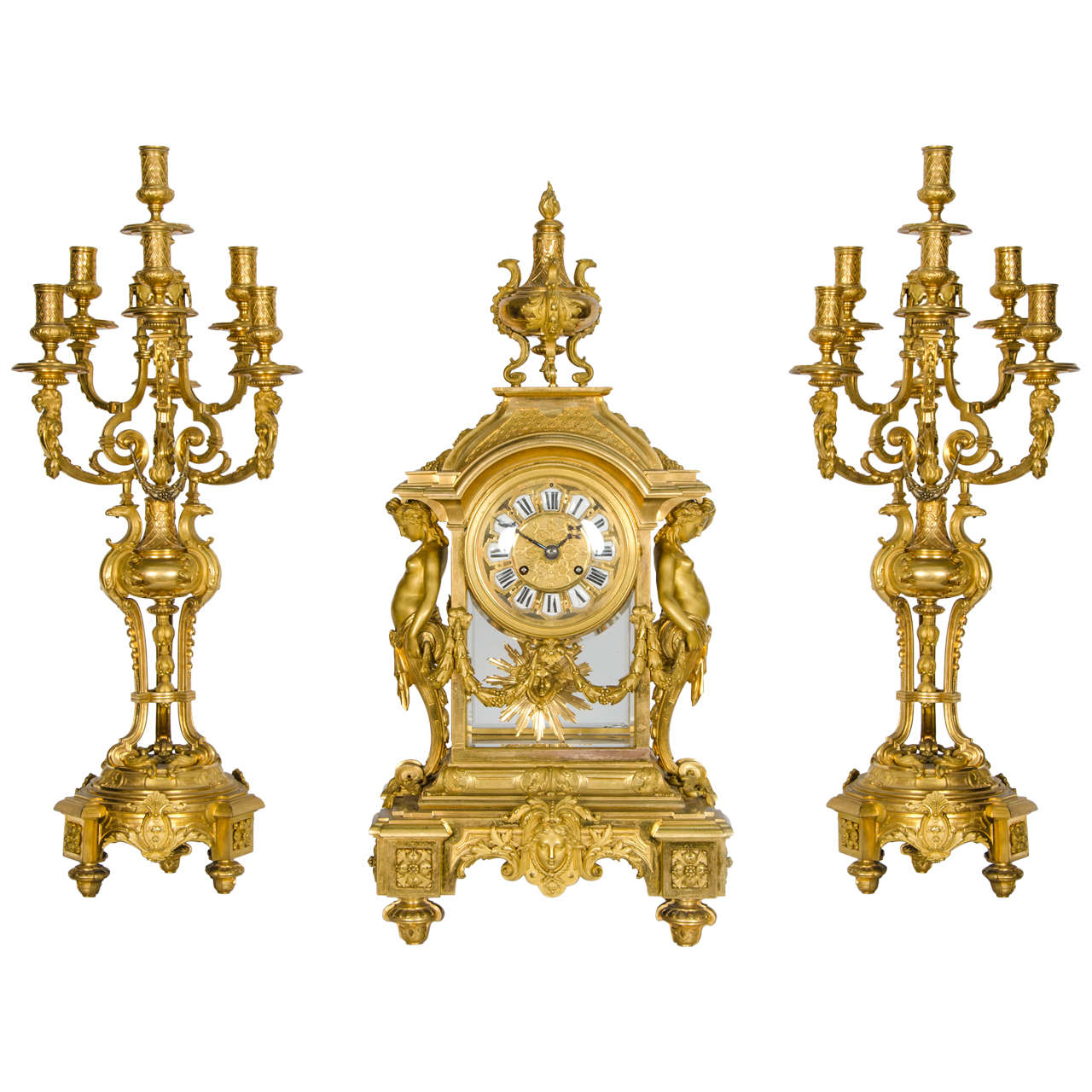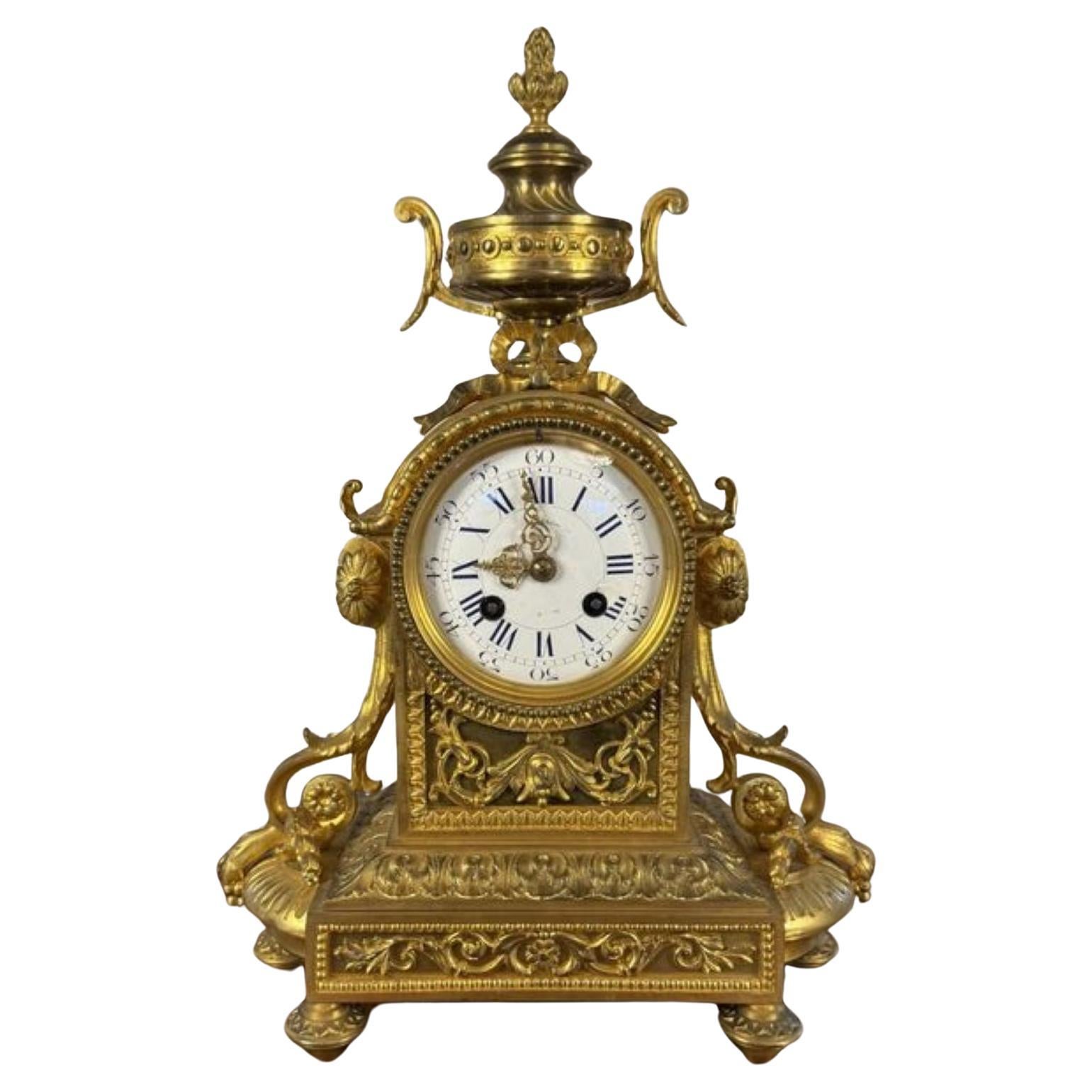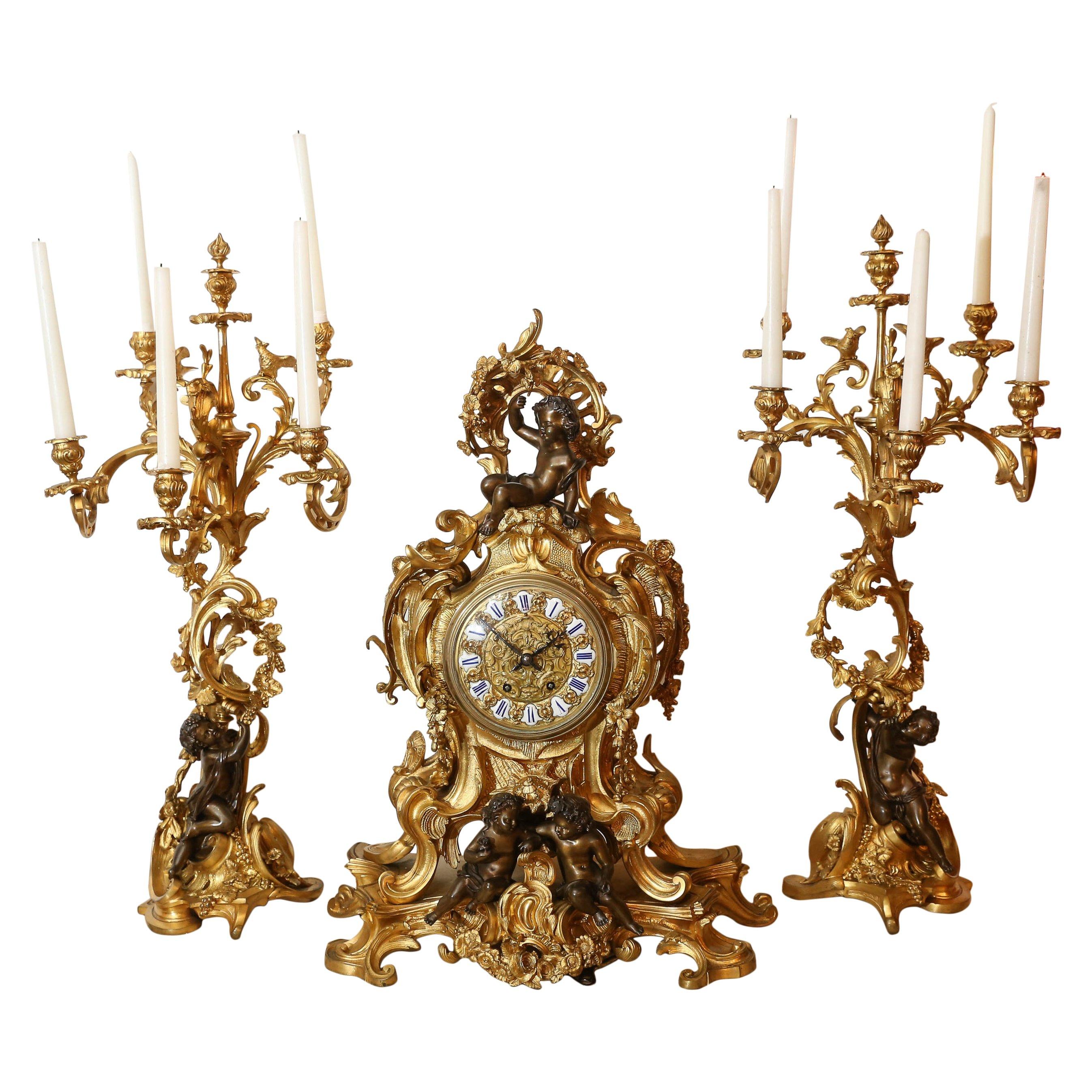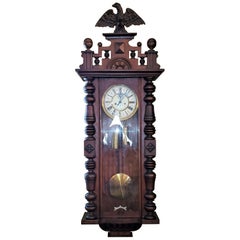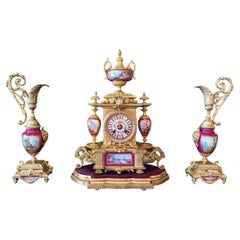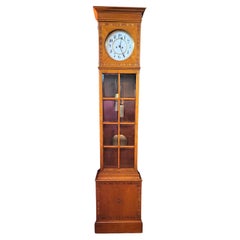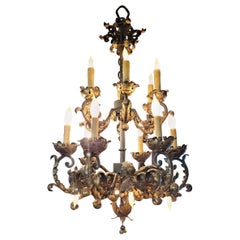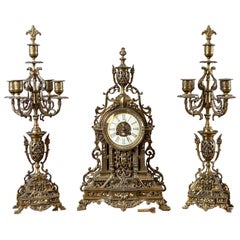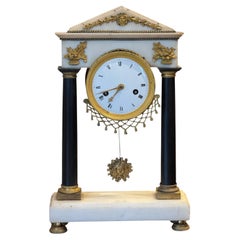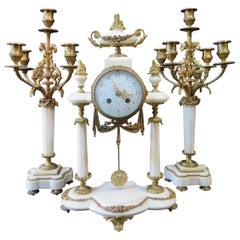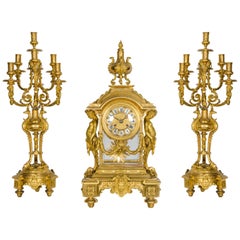Items Similar to 19C French Mantle Clock with Candelabra Garnitures by J. Marti (Paris)
Want more images or videos?
Request additional images or videos from the seller
1 of 18
19C French Mantle Clock with Candelabra Garnitures by J. Marti (Paris)
$7,800per set
£5,967.61per set
€6,824.90per set
CA$11,106.52per set
A$12,029.69per set
CHF 6,371.46per set
MX$145,541.30per set
NOK 80,099.11per set
SEK 74,669.39per set
DKK 50,971.43per set
About the Item
PRESENTING A STUNNING Mid 19th Century French Slate & Bronze Mantel Clock by Marti with pair of slate and bronze candelabra’s as garnitures.
This ‘large’ mantle clock, was made circa 1860, by the famous French and Parisienne Clockmaker – ‘J. Marti et Cie’ of Paris, and is fully and properly marked.
‘Marti Clocks’ are highly desirable and highly collectible as they were of the finest quality, BUT this Clock is one of the FINEST EXAMPLES of a Marti Black Slate and Bronze mantel clock we have EVER seen.
The bronze detail is ‘Spectacular’
From the top, the clock is topped by a large bronze exotic palm leaf and ball bronze finial, which sits on a square plinth or platform.
Then it extends to an angular arched pediment with bronze floral wreath insert into the center.
The next section, consists of a central bronze scene of 2 cherubs floating on water with a fish.
This is flanked on either side by a floral rose medalion in bronze.
It then extends downwards with 2 Corinthian Style bronze columns, with the main insert being bronze neo-classical or goddess figures (each one different than the other).
The dial, clock face, hands and roman numerals are behind a glass cover and is bordered in gilt bronze decoration, in near perfect condition.
2 keyholes … one for winding up the movement and one for the striking chime.
Beneath the clock face, there are again floral bouquets, with a glorious central bronze lion’s head.
The 2 Columns are based with gilt bronze platforms.
The base platform again, has a central bronze wreath and swag, flanked on either side by blank armorial shields.
It sits on four gilt bronze platform feet.
The movement is accessed at the rear (which has a replacement glass cover, which in our opinion is better than the usual brass covers, as you can see the pendulum and movement at all times) and it has a lead weighted pendulum with a striking movement (probably an 8 day movement) that strikes on the hour and half hour. It has it’s original key. It needs servicing to have working properly but appears to be missing no parts.
It is marked “Medaille de Bronze – J. Marti & Cie” and has serial numbers.
The pair of 19C French Candelabra Garnitures, whilst not a ‘perfect’ match for the clock, are very sympathetic to the clock and make a fine visual match to complete the set.
Made in France also around 1860, each has a black slate & bronze footed square base, which extends upwards to another tapered baluster shaped central slate section with 5 arms/branches for candles and decorated in floral motif’s.
” Medaille de Bronze” means bronze medal which was the award received in 1860. The name of the company was originally J. Marti et Cie and then, Samuel Marti & Cie. The medal, a second class one, was received at the Paris Exhibition of 1855. The company also received a Medaille d”Or(gold Medal) in Paris, 1900.
There are also references to J Marti Circa 1860 and Fritz Marti in 1900.
MARTI, SAMUEL et Cie
1860 – Medaille de Bronze
1889 – Medaille d’Argent
1900 – Medaille d’Or
1931 – Grand Prix, Paris
MARTI, FRITZ
1900 – Medaille d’Or,Paris
Provenance: Clock from a Dallas Private Collection and Candelabra’s acquired from a dealer in France.
Condition: Very good. Needs a servicing to be fully operational. Has it’s original key and the clock mechanism appears to be fully intact. 2 very minor repairs to the slate on the top corners and replacement glass cover on rear. Otherwise, very good. Servicing cost reflected in pricing.
Dimensions: Clock – 26 inches Tall, 6.8 inches deep and 11.2 inches Wide.
Each Candelabra – 17.5 inches Tall, 5.5 inches deep and 7.5 inches Wide.
Clock weighs circa 30lbs
Candelabra’s weigh circa 2lbs each
- Creator:Marti (Clockmaker)
- Dimensions:Height: 26 in (66.04 cm)Width: 11.2 in (28.45 cm)Depth: 6.8 in (17.28 cm)
- Sold As:Set of 3
- Style:Neoclassical Revival (Of the Period)
- Materials and Techniques:
- Place of Origin:
- Period:
- Date of Manufacture:1860
- Condition:Repaired: See full listing. Wear consistent with age and use. Minor losses. Minor structural damages. Minor fading.
- Seller Location:Dallas, TX
- Reference Number:1stDibs: LU3978145208532
About the Seller
4.9
Gold Seller
Premium sellers maintaining a 4.3+ rating and 24-hour response times
Established in 2015
1stDibs seller since 2018
397 sales on 1stDibs
Typical response time: <1 hour
- ShippingRetrieving quote...Shipping from: Dallas, TX
- Return Policy
More From This Seller
View All19C Gustav Becker Vienna Wall Clock
Located in Dallas, TX
PRESENTING A GORGEOUS 19C Gustav Becker Vienna Wall Clock.
Made by the famous clockmaker, Gustav Becker circa 1880 in Germany.
Th...
Category
Antique Late 19th Century German Victorian Wall Clocks
Materials
Brass
French 19C Japy Freres & Red Sevres Porcelain Mantle Clock with Garniture Set
By Phillipe Mourey, Manufacture Nationale de Sèvres, Japy Frères
Located in Dallas, TX
PRESENTING A STUNNING mid to late 19C French Japy Freres & Red/Magenta Sevres Porcelain Mantle Clock with Garniture Candlestick Ewers.
The clock movement is by the famous Parisienne Clockmaker … ‘Japy Freres’ and the clock dial has the marks for “JAY” (short for Japy Freres) & “Paris” on the dial face.
The clock mechanism and clock face/dial have matching serial numbers of “7225”. The movement also has the numbers: “5 – 2”.
The clock face/dial also has the initials: “D.H.”.
The gilt ormolu clock case is gilt spelter and is signed on the rear base, for having been made by “P.H. Mourey” of Paris, who worked with and for ‘Japy Freres’, towards the end of the 19th Century.
The signature of ‘Mourey’ also bears the numbers “85” … probably for 1885, but could also be the serial number.
Taking into account Mourey’s historical association with Japy, being late 19th Century, we are leaning heavily towards this being the date of manufacture i.e. 1885.
The Clock has RARE red/magenta Sevres hand-painted porcelain paintings/additions, to include:-
(i) a 2 handled and lidded urn on the crown with pointed flame finial,
(ii) a pair of bulbous urns either side of the main body and clock face,
(iii) the clock face and dial itself and
(iv) a flat rectangular medallion on the front base.
The crown urn and the base medallion both have similar themes, but different painted scenes, depicting French rural countryside scenes with cottages, rivers and bridges.
The porcelain urns on the sides, likewise have hand-painted images of a young boy, in rustic period attire on the right and a young girl on the left.
None of these paintings appear to be signed.
The clock case has GLORIOUS detail to it, with scrolls, ribbons, vines, grapes and Corinthian columns.
The clock sits on a custom made gilt wood and burgundy velvet plinth, that is original to the piece and was a common accent with ‘Japy Freres Clocks’, when originally retailed in their Paris shop.
The rear of the clock is plain and the perspex/clear resin plate insert, is a new addition, but a nice addition, in that it allows one, to view the movement and pendulum works.
The clock is an 8 day movement with a strike on the hour and half hour. The clock face has 2 winding holes … one for the pendulum movement and the other for the striking chime/ring.
Unlike British clocks this clock does not have a long musical chime … it is a simple ‘single strike’ on the half hour.
The red/magenta Sevres porcelain clock face/dial is in SUPERB condition. Roman numerals with gilt accents and a hand-painted circular wreath/bouquet of spring flowers on the center section.
To complete the set, we have a matching pair of gilt ormolu spelter and hand-painted red/magenta Sevres porcelain Ewers … which can hold a single candle each.
The porcelain urns on the central section, have hand-painted images of a young lady in rustic period attire … fishing on the riverbank on the right and a young man playing the flute in the countryside on the left.
The front base medallions on each ewer have hand-painted wreaths/bouquets of spring flowers.
The clock facing side of the porcelain urn on each Ewer, has a brass ormolu applique head, of the Greek god of wine-making, orchards and fruit, vegetation, fertility, festivity, insanity, ritual madness, religious ecstasy, and theatre, namely, Dionysus.
The plinths are signed on the rear top left corner, and we think they read: “R.P. Unfaut”. They also bear the numbers “61” and “69”, Again, possibly for 1861 and 1869, but here we think it is more likely they are serial numbers, as it is highly unlikely that a matching pair were made 8 years apart!
Whilst we cannot find any information on ‘R.P. Unfaut’, we can only guess that he/she/they worked with, or for, ‘Japy Freres’, as these ewers are unmistakably, a ‘superb’ match for the clock!
The style, subject matter, gold banding and edging, around the paintings, are virtually ‘identical’ to the same decorations on the clock’s porcelain paintings.
The Ewer on the left (with the boy playing the flute) appears to have a faded signature on the gold border of the painting towards the base and we think it is the signature of ‘Alexandre Evariste Fragonard’ …. one of the best known artists attached to Sevres in the mid 19th Century … meaning, that these Ewers were probably made circa 1845-50.
The quality and detail to these 2 paintings is classic Fragonard!
We are of the opinion, therefore that these garnitures, were made circa 35/40 years before the clock, as Mourey was prevalent with Japy around 1880 – 1900.
The clock paintings are of a very similar, rustic ‘Fragonard Style’ subject matter and although unsigned, could possibly have been painted by a Sevres artist, to replicate the Fragonard paintings...
Category
Antique 19th Century French Rococo Revival Mantel Clocks
Materials
Ormolu
Art Deco Portois and Fix Viennese Tall Case Clock
By Portois & Fix
Located in Dallas, TX
Presenting an amazingly rare piece of Art Deco furniture by an exceptionally rare maker, namely, an Art Deco Portois and Fix Viennese Tall Case Clock.
...
Category
Early 20th Century Austrian Art Deco Grandfather Clocks and Longcase Clocks
Materials
Brass
19C French Gilt Bronze 18 Branch Chandelier
Located in Dallas, TX
Presenting a beautiful 19C French gilt bronze 18 branch chandelier.
Made in France circa 1880/90.
18 Branches and 18 bulbs.
Rococo Revival (Third Republic) heavily influence...
Category
Antique Late 19th Century French Rococo Revival Chandeliers and Pendants
Materials
Bronze, Ormolu
$4,200 Sale Price
50% Off
19th Century Large French Ormolu and Alabaster Chandelier
Located in Dallas, TX
Absolutely gorgeous 19th century French chandelier in the Louis XVI style.
Ormolu and brass central columns and supports. Central column surrounded by three laurel wreaths.
Three sheafs of wheat top the shade. Large alabaster shade with orange/brown mottled tones, the two internal lights make it transparent. Eight bulbs, two internally inside the shade and 6 on the outside, each with a frosted glass shade with brown and orange tones. Each external light...
Category
Antique Late 19th Century French Louis XVI Chandeliers and Pendants
Materials
Alabaster, Ormolu
Large 19 Century French Rococo or Neoclassical Revival Style Vitrine
By David Roentgen
Located in Dallas, TX
Stunning 19th century French Empire, neoclassical/Rococo Revival style Marquetry vitrine or display cabinet, of large proportions!!
A real statement piece!
Made of a fabulous variety of veneers, including kingwood, satinwood, tulipwood, harewood and walnut with quality classical ormolu mounts.
It has ebonized pillars in the Empire style, with walnut and exotic hardwood friezes in the Rococo style.
Double glass doors to middle section and single glass doors on either side.
The glass on the doors are framed in ormolu banding.
Floral Marquetry panels on front and parquetry on the sides.
The front central section is a pullout / pull-out drawers with gorgeous walnut frieze panel and original carved walnut knobs.
Scrolling pelmet on the top in 3 sections banded in ormolu beading.
Scrolling base with cabriolet feet and ormolu mounts on base.
Various ormolu mounts, floral mounts, mounts of Baachus and mounts of neoclassical female figures.
In 3 sections. with 2 side cabinets and large central section with 3 section pelmet, stunning piece!!!
The quality ormolu mounts are marked with the letter “R” and what appears to be “FR 678”.
We were originally of the belief that this piece might have been made at the very end of the 19th century, but having regard to the quality of workmanship throughout this piece we are of the opinion that it was most likely made in the third quarter of the 19th century, circa 1870 and by an obviously top quality Parisienne maker with a surname beginning with “R”.
It is definitely in the style of David Roentgen who was known for his Rococo/neoclassical styles.
David Roentgen, (born Aug. 11, 1743-died Feb. 12, 1807, Wiesbaden, Duchy of Nassau), cabinetmaker to Queen Marie-Antoinette of France; under his direction the family workshop at Neuwied (near Cologne), founded by his father, Abraham Roentgen, became perhaps the most-successful firm of furniture production in the 18th century.
After succeeding his father as head of the Neuwied workshop in 1772, Roentgen strove to broaden their clientele, an ambition that brought him first to Hamburg and ultimately to Paris (1774), where in 1779 he was spectacularly successful in selling his finest furniture to King Louis XVI of France for £3,300 to £4,000, an unprecedented sum for the time.
Appointed cabinetmaker to the queen, Roentgen was granted admission (1780) as maître-ébéniste (master cabinetmaker) to the trade corporation of Paris cabinetmakers, making it possible for him to keep in Paris a stock of the furniture manufactured at Neuwied. Thus he was able to compete with such great cabinetmakers as Jean-Henri Riesener and Adam Weisweiler, reputedly his former pupil at Neuwied. After his first visit to St. Petersburg, Empress Catherine II the Great bought huge quantities of his furniture; King Frederick William II of Prussia was also his client. When in 1795 the French Revolutionary armies threatened to cross the Rhine, Roentgen evacuated his establishment and moved his stock farther inland. Unfortunately, he lost everything in his Parisian salon and in his Neuwied workshop, both of which were sacked by Republican troops. He was crushed, despite his appointment as court furnisher to the king of Prussia. Although he never succeeded in starting production again, former apprentices of his whom he helped to establish in the German cities of Berlin (David Hacker...
Category
Antique Mid-19th Century French Rococo Revival Vitrines
Materials
Ormolu
$9,600 Sale Price
48% Off
You May Also Like
Unique French-Style Mantel Clock With Candelabras, Early 20th Century
Located in Opole, PL
Unique French-Style Mantel Clock With Candelabras, Early 20th Century
A unique French-style set with a mantel clock and two four-arm bras...
Category
Early 20th Century French Baroque Revival Mantel Clocks
Materials
Brass
$3,328 Sale Price / set
20% Off
19th Century French Empire Style Mantel Clock With Ormolu Mounts
Located in Charlottesville, VA
French mantel clock in the Empire style, featuring a white marble case with black column supports and classical gilt bronze (ormolu) accents. The triangular pediment is detailed with...
Category
Antique 19th Century French Mantel Clocks
Materials
Marble, Metal, Enamel
19th Century French Clock Set
By G. None
Located in Bronx, NY
This vintage 19th century marble & dore' bronze clock set is beautifully designed in a Louis XVI motif. The clock features a decorative hand painted round enamel face with Arabic num...
Category
Antique Late 19th Century French Louis XVI Mantel Clocks
Materials
Marble, Bronze, Enamel
$5,500 / set
Imposing 19th Century French Ormolu Clock Garniture 29"(73cm) high
Located in Brighton, Sussex
A large and impressive, very good quality French gilded ormolu clock garniture. The clock supported by a pair of Caryatids, decorated with swags and classical motifs, four bevelled g...
Category
Antique 1860s French Mantel Clocks
Materials
Ormolu
Fantastic quality antique Victorian French mantle clock
Located in Ipswich, GB
Fantastic quality antique Victorian French mantle clock, having a quality antique Victorian French mantle clock with a French eight day movement striking on bell, with circular ename...
Category
Antique Early 19th Century French Early Victorian Mantel Clocks
Materials
Brass
French Clock and Candleabrum Grand Scale Garniture Set
Located in Houston, TX
Bronze dore clock and Candleabrum are decorated with cherubs in a dark
Patinated bronze. This grand and elaborate set is in lovely condition.
The rococo design incorporates five c...
Category
Antique Early 19th Century French Mantel Clocks
Materials
Bronze
More Ways To Browse
Bronze Goddess
Replacement Glass
Furniture With Gold Inlay
Clock Dial Face
French Clock And Candelabra
Mantle Garniture
Mantel Clock With 2 Candelabras
Clocks Circa 1860
Neoclassical Mantle
Slate Mantel
Marti Bronze Mantel Clock
Brass Clock Garniture
Antique Slate Clock Clocks
Mantel Clock With Candelabra
Antique Slate Mantel Clocks
Antique French Clock With Garnitures
Antique French Slate Clock
Antique Black Slate Clock

